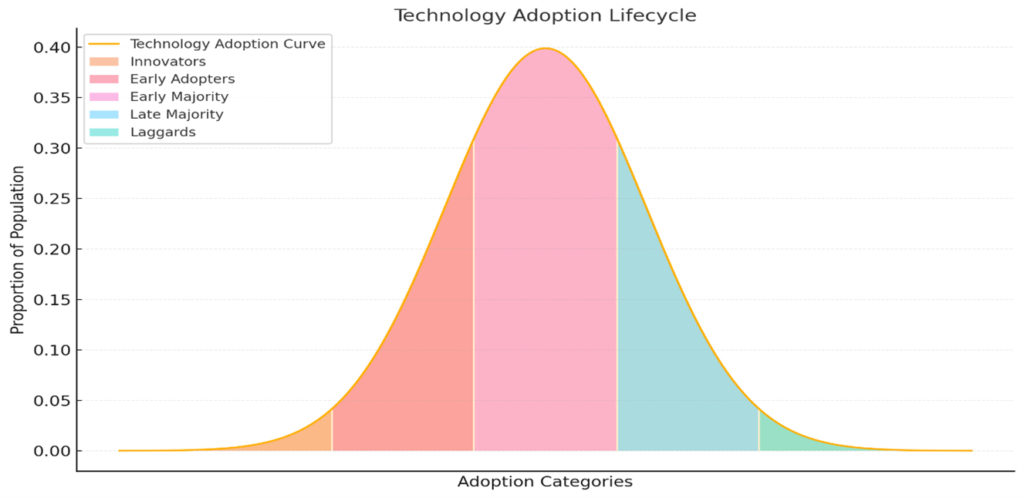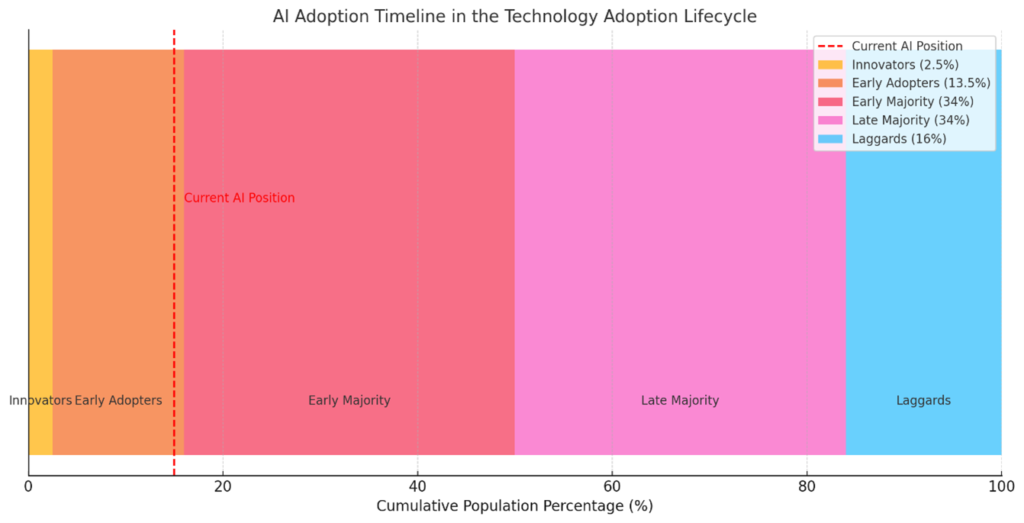What is AI Transformation and Why It Matters in 2025?
Artificial intelligence (AI) is reshaping industries and revolutionizing the way businesses function. As we approach 2025, AI adoption is no longer optional; rather, it has become a strategic necessity for maintaining a competitive edge. Consequently, businesses must learn to address operational inefficiencies, solve complex challenges, and leverage AI’s transformative capabilities to unlock unprecedented opportunities. This article explores the foundational steps of AI transformation—education, consultation, implementation, and optimization—and emphasizes how businesses can harness AI to drive innovation and growth in a rapidly evolving landscape.
The Technology Adoption Lifecycle for AI explained
To understand how businesses are or will adopt AI, it helps to understand the technology adoption lifecycle. People and businesses adopt new technology in five stages, here’s a brief explanation of each category in the Technology Adoption Lifecycle:
The Technology Adoption Lifecycle provides a framework for understanding how businesses adopt new technologies, including AI. This model divides adoption into five distinct stages:
- Innovators: Enthusiastic early adopters willing to experiment with untested technologies.
- Early Adopters: Visionary leaders and influencers who validate technology’s practical applications.
- Early Majority: Pragmatic adopters seeking proven solutions before investing.
- Late Majority: Skeptical users who only adopt technology after it becomes widely accepted.
- Laggards: Conservative holdouts who resist change until adoption is unavoidable.
Currently, most businesses are in the Early Majority phase of AI adoption, which presents a significant opportunity to engage and educate these organizations. By guiding them through pilot projects, offering data-driven insights, and collaborating on tailored solutions, businesses can transition smoothly into more advanced stages of AI integration. Success stories from similar industries can further reinforce the value of AI, fostering confidence and accelerating adoption. Technology adoption life cycle – Wikipedia
The AI Adoption Lifecycle
The diagram below (Diagram 1) illustrates the Technology Adoption Lifecycle. The Early Adopter phase, marked in orange, represents a pivotal moment for driving engagement with AI solutions. This phase also underscores the untapped potential within the Early and Late Majorities’ and Laggards, who remain cautious yet reachable through strategic interventions.
Diagram 1.

This diagram below (Diagram 2) visually represents the Technology Adoption Lifecycle with cumulative population percentages for each category. The red dashed line indicates where we currently are in the AI adoption timeline—likely in the Early Majority phase. This reflects that a significant portion of the population is now exploring AI after observing its proven value, but there remains a large untapped market across the lifecycle.
Diagram 2.

Four Key Steps to help Business Accelerate AI Transformation
To maximize the impact of AI and participate in the development of the this relatively new market AI agencies should focus on these four transformative steps:
Education
A lack of understanding often hinders adaptation.Comprehensive education programs should:
- Explain the core principles and functionality of AI.
- Highlight benefits and address common risks or misconceptions.
- Showcase real-world examples demonstrating AI’s success in specific industries.
Tailored education builds trust and positions your organization as an authority. For instance, a targeted workshop for small retail businesses could demonstrate how AI optimizes inventory management, reducing waste and increasing profitability. Such initiatives establish credibility while fostering interest in AI solutions.
Consultation
Once businesses grasp AI fundamentals, they require expert guidance to:
- Assess organizational readiness for AI integration.
- Identify low-hanging opportunities and high-impact use cases.
- Develop a clear, actionable roadmap tailored to their strategic goals.
Consulting bridges the gap between theoretical understanding and practical application, enabling businesses to align AI capabilities with their operational needs.
Implementation
Block contains unexpected or invalid content.
Attempt recovery
Effective implementation transforms strategic plans into operational reality, which include;
- Designing AI systems customized to specific business needs.Rigorous testing and iterative improvements to ensure seamless integration.Training employees to confidently use and manage AI tools.
Collaborating with data scientists, software developers, and change management experts enhances the implementation process. For example, a retail company partnering with an AI consultancy implemented a machine learning system for inventory management, achieving a 35% cost reduction within six months while improving overall efficiency.Retail Chain – 35% Cost Reduction in Supply Chain Operations Using AI/ML Insights – AllKenso
Optimization
AI systems require continuous refinement to remain effective and aligned with evolving business goals. Ongoing support involves:
- Regular updates to maintain security and functionality.
- Adapting systems to address emerging challenges and opportunities.
- Ensuring AI tools consistently deliver value through periodic performance reviews.
- This proactive approach maximizes ROI and ensures long-term success in AI adoption.
Opportunities for Small Businesses
Small businesses can leverage AI to enhance their operations, even with limited budgets and resources. Key opportunities include:
- Process Automation: Small businesses can use AI to automate repetitive tasks like data entry, inventory management, and customer inquiries. For example, AI-powered chatbots can handle customer service, freeing up time for employees to focus on growth strategies.
- Personalized Marketing: AI tools such as customer segmentation and predictive analytics can help small businesses target customers more effectively, improving engagement and sales.
- Enhanced Decision-Making: By analyzing business data, AI can provide small businesses with actionable insights. For instance, AI-driven sales forecasts can guide inventory planning and reduce waste.
- Cost Efficiency: Many off-the-shelf AI solutions are affordable and require little technical expertise, making it easier for small businesses to adopt AI without significant upfront investment.
30 Best AI Tools for Small Businesses & Startups in 2025
Table: Small Business Problems and AI Solutions
| Small Business Problems | AI Solutions |
|---|---|
| Time-consuming manual tasks | AI-powered automation tools for data entry and admin |
| Limited customer engagement | Chatbots and AI-driven personalized marketing |
| Inefficient inventory management | AI-based inventory forecasting and tracking systems |
| Difficulty analyzing business data | AI tools for data visualization and actionable insights |
| High costs of scaling operations | Affordable AI tools to optimize resources and scale |
Opportunities for Medium Businesses
Medium-sized businesses are well-positioned to adopt AI at a broader scale, using it to compete with larger firms while maintaining agility. Opportunities include:
- Scalable Automation: Medium businesses can automate more complex processes, such as supply chain optimization and advanced customer support systems, to drive efficiency and reduce operational costs.
- Workforce Augmentation: AI can augment the capabilities of employees by providing tools for real-time decision support, such as AI-powered project management software or HR analytics.
- Customer Experience Enhancement: AI can be used to offer personalized experiences, such as product recommendations, dynamic pricing, or loyalty program optimization, helping medium businesses stand out in competitive markets.
- Data-Driven Strategy: Medium businesses typically have access to more extensive datasets than small businesses. Leveraging AI to analyze these datasets can uncover new opportunities, optimize resource allocation, and enhance strategic planning.
Opportunities for AI Agencies
AI agencies have a pivotal role in facilitating successful AI adoption across industries. Key strategies for agencies include:
- Custom Education: Develop specialized learning programs tailored to the needs of specific sectors, such as healthcare or retail. For instance, healthcare organizations could benefit from AI-powered scheduling systems, while retailers might focus on predictive analytics for sales trends.
- Bundled Services: Offer comprehensive packages that combine education, consulting, implementation, and support. These services can be tailored to fit businesses of varying sizes and budgets, creating accessible entry points for AI adoption.
- Strategic Partnerships: Build networks of domain experts, data scientists, and developers to deliver robust solutions. Partnerships enable agencies to tackle complex challenges and expand their capabilities.
- Proprietary Tools: Create AI tools designed to solve recurring industry pain points, such as compliance tracking or customer behavior analysis. For example, an AI-driven compliance system could streamline audit processes for financial institutions, enhancing efficiency and reliability.
- Niche Specialization: Focus on a specific industry to develop deep expertise and replicate successful implementations efficiently. Specialization builds credibility and positions the agency as a trusted leader in that field.
Conclusion
In the 1990s, the internet revolutionized the way we connect, share information, and do business, creating a truly global network. The 2000s brought the rise of mobile technology, putting the power of computing into our hands and enabling instant communication, seamless collaboration, and on-the-go solutions. Each of these technological leaps reshaped the way we live, making the world faster, smarter, and more connected.
Today, artificial intelligence (AI) is the next great revolution, building upon these advancements to take innovation to unprecedented heights. AI is not just automating processes—it’s transforming decision-making, unlocking efficiencies, and driving smarter outcomes across every industry. Just as the internet democratized access to information and mobile technology made the world accessible in our pockets, AI is adding intelligence to this connectivity, empowering businesses to analyze data, predict trends, and adapt in real time.
From revolutionizing workflows to redefining healthcare, education, and entertainment, AI is the ultimate game-changer of the 21st century. It offers unparalleled opportunities for innovation and growth, enabling industries to work faster, create more, and achieve goals once thought impossible. Like the internet and mobile revolutions before it, AI isn’t just another technological advancement—it’s a movement that will shape the future. Don’t just watch the AI transformation happen—be a part of it and lead the way into this bold, intelligent new era.
AI transformation is about more than adopting new tools—it’s about reimagining possibilities and achieving exceptional outcomes. By following the steps outlined in this paper, businesses and agencies can navigate the complexities of AI adoption and emerge as leaders in their industries. As we approach 2025, the potential for AI to drive growth, creativity, and success has never been greater. Embrace the journey, and become a catalyst for innovation in the AI revolution.
Call to Action
The current landscape presents an unprecedented opportunity for businesses and AI agencies to lead the transformation toward AI-powered operations. Begin by identifying a high-impact area within your organization—such as customer engagement, supply chain optimization, or operational efficiency—and take the first step through targeted workshops, pilot programs, or expert consultations.
This is the moment to drive change. By adopting a proactive approach, organizations can unlock new levels of innovation, efficiency, and competitiveness. Together, we can shape a future where AI empowers businesses to reach their full potential and redefine industry standards.
